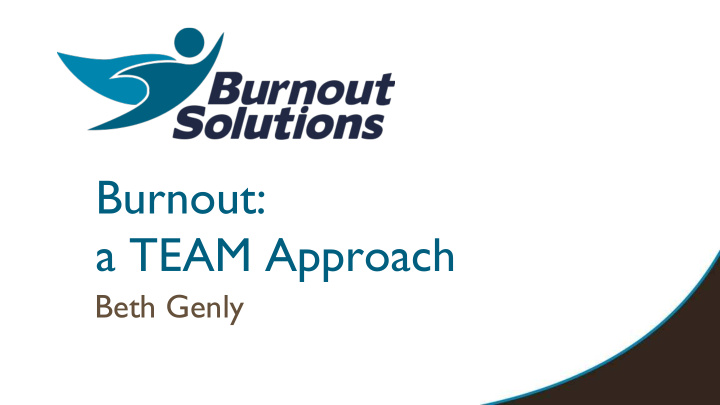



Burnout: a TEAM Approach Beth Genly
“Resilience is how you recharge, not how you endure.” ─ Shawn Achor
“Talked my head off Worked my tail off Cried my eyes out Walked my feet off Sang my heart out So you see, There’s really not much left of me.” — Shel Silverstein
When the going gets tough...
Mindset: How do you motivate yourself? Give yourself permission to slow down or take a break? Expect more from yourself than you would from anyone else? Guilty or embarrassed about being burned out? (p.1)
Would your answers be different if your injury (burnout) was the result of a more conventional injury, like a broken bone?
The Midwife’s Dictum Successful labor has a rhythm: Work hard, rest deeply, work hard, rest deeply...
The Road Forward What is burnout? How do we recharge? How best to share this info?
─ Maslach & Jackson (1981) The Maslach Burnout Inventory (p.2)
Burnout is a Masked Bandit What does burnout masquerade as? What does burnout steal from you? (p.2)
Burnout as a Repetitive Use Injury 1.Diagnose and treat injury 2.Incident report / safety evaluation 1.Address immediate needs 2.Recover strength and productivity 3.Create a plan
Identify Your Rumble Strips! Withdrawing from Using food, drugs, or responsibilities alcohol to cope Isolating yourself from Taking out your frustrations others on others Procrastinating, taking Skipping work or coming in longer to get things done late and leaving early (p.2) (Harvard HelpGuide: Burnout)
What to Do? Dr. Marnie Loomis, N.D.
5 Key Ar Areas as
Burnout Shield Loomis. Hol. Pri. Care, 2015
Self lf-Ca Care How high a priority do I set on my own health and wellbeing? Reflec lectio ion & & How frequently do I reflect on my accomplishments and what is meaningful to me? Recognit itio ion Capacity ty Given my situation and internal characteristics (which are, for Vulnerable? the most part, things that are out of my control), what is my vulnerability to burnout? Adequate? Communi unity Do the people around me, and my relationships to them, help Well- protect me, or make me more vulnerable to burnout? Protected? Coping ng Am I creating distractions or diversions, instead of bringing my best resources to the problem? (p.3)
You Matter! so K.I.S.S.Y. How do pressures to always think of others first show up in your life? When you maintain good boundaries for yourself, name 5 benefits to others. (p. 4)
Burnout Shield Capaci city
Sleep Soderstrom, J. Occup. Health Psych., 2012 Inadequate sleep predicts burnout
Would you…?
Not Enough Sleep ↓ reaction time ↓ vigilance ↓ decision-making ability Poor judgment Distraction during complex tasks
Sleeping 6 Hours a Night Alhola. Neuro. Dis. & Trtmt, 2007 Mild Sleep Deprivation Cognitive performance Alertness Overeating Mood issues
2 Weeks of 6 Hours a Night Performance = 48 hours with no sleep Performance got worse every day
"We would neve ver say, "This person is a great worker! He's drunk all the time!" yet we continue to celebrate people who sacrifice sleep for work." ─ Charles Czeisler, MD
7 – 9 Hours / Night
Burnout Shield Capaci city
The Miracle Minute Roland Jarka, PhD. “Miracle Minute,” YouTube, 2014 Breathe Grateful Recognize Intention Ask (p.4)
Recognition – Small Victories (p. 5)
Burnout Shield C apa pacity
Capacity List Roles, hats, responsibilities • 3-5 things (for each role) • Tally against clock or calendar • Talk • Feel? • Realistic?
Capacity Future Self Envision … (p.5)
Assess the Load and Envision Success
Burnout Shield Capaci city
Ask for Help (p. 5)
Burnout Shield C ap apac acity
Coping Styles Venting (p. 6)
Coping Styles Flip the Script
Flip the Script ive. (Can’t → can) Passiv ive t e to activ ng. (Hate → appreciate) Negati ative f feeling ng to positi tive f feeling. Past to t to futu ture. (If I did… If I could…) Fu Futu ture to to past. t. (When have I already…?) Liabi bility ty t to asset. t. (What’s good about this?)
Pick a Script
Flip the Script ive. (Can’t → can) Passiv ive t e to activ ng. (Hate → appreciate) Negati ative f feeling ng to positi tive f feeling. Past to t to futu ture. (If I did… If I could…) Fu Futu ture to to past. t. (When have I already…?) Liabi bility ty t to asset. t. (What’s good about this?) (p. 6)
What Did You Learn?
Track Your Progress
Dashboard C ap apacity (p. 6)
Wrap It Up
Capaci city ty
"Resilience is how you recharge, not how you endure.” ─ Shawn Achor
Beth Genly 503-267-4482 beth@burnout-solutions.com facebook.com/burnoutsolutions
Recommend
More recommend